It should be remembered that the September campaign did not consist only of battles fought by soldiers. On the very first day of the war, the Germans began the systematic extermination of the Polish population. Here are some of their most heinous crimes. For memory and warning.
From the very first day of the war, the Germans were terrified of the alleged Polish partisans, lurking at every window and around every corner. The commanders also aroused paranoid fear, despite the fact that in September, the Wehrmacht was fought by uniform, regular units of the Polish Army, and not by any insurgents.
The general of one of the German divisions - quoted in Jochen Böhler's book:"Invasion 1939. Germany against Poland" - wrote in a memo that the Polish population is fanatically inclined, incited against Germany. An intelligence officer from another unit, in the same spirit, recommended to the soldiers: The population should be treated severely (…) If necessary, intervene ruthlessly ”. And that's what the Wehrmacht members did, in their entirety.
Częstochowa. A preventive crime against the "guerrillas"
It took only four days for images to take precedence over reality. On September 4 in Częstochowa there was - quoting the words written in the diary of a German military doctor - a senseless shooting in the very center of the city.
From the very beginning, there were no signs of Poles participating in this incident - most likely the hyperactive Germans started shooting, to which their frightened colleagues responded. No armed Poles were found, nor any weapons abandoned by them.
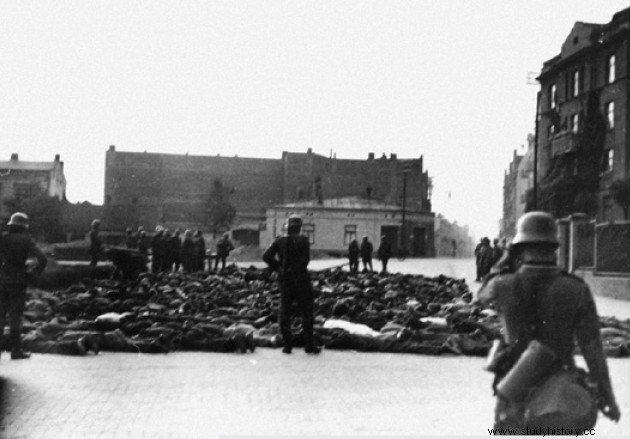
Polish and Jewish civilians crammed into a square in the center of Częstochowa. Over two hundred of them did not survive that day (Example illustration from Jochen Böhler's book "Invasion 1939. Germany against Poland").
Nevertheless, the soldiers of the German 42nd Infantry Regiment herded the entire civilian population to the square in the center of the city. A participant in these events, Helena Szpilman, said after the war:
We all had to go under their convoy with our hands up. Poles and Jews were walking (….). Several thousand people were gathered there, men, women and children. The whole square is surrounded by the German army. The Germans had their rifles in their hands ready to fire (...). They searched Jews and Poles men in detail. When they found someone with a razor blade, a razor or a pocket knife, they escorted him to a Polish anti-aircraft vehicle and shot him immediately .
Many people died before reaching the square - German soldiers were clearly ordered to shoot anything that moves. That day in Częstochowa died at least 227 people although the Wehrmacht admitted to executing "only" 96 men and three women.
Puppy. The whole village was set on fire
A similar situation as in Częstochowa took place on the night of September 1-2 in a small village-street on the Prosna River - Torzeńcu. According to the official log of combat operations of the regiment, after sunset, the resting soldiers were attacked by ... the entire population of the village, including women!
Surprisingly, there is no mention in the documents of even one civilian caught with a gun in his hand, or of the discovery of any pistols, rifles and rifles at all. Not even a single aggressor was captured, and only three Germans were killed in this mysterious attack. It would be unimaginable if the entire village actually pounced on the exhausted soldiers.
The complete senselessness of such a vision of events did not bother the command of the 41st Infantry Regiment at all. After a quick trial, 17 or 18 civilians were shot. However, it did not end there. In the morning the whole village was shelled with mortars and burned down. The German historian investigating this crime, Jochen Böhler, stated in his book "Invasion 1939":
If the reason for attacking the regiment is not considered the participation of the Polish population in the battles, but rather the common delusion among soldiers, then this turn of events is hardly surprising (p. 194) .
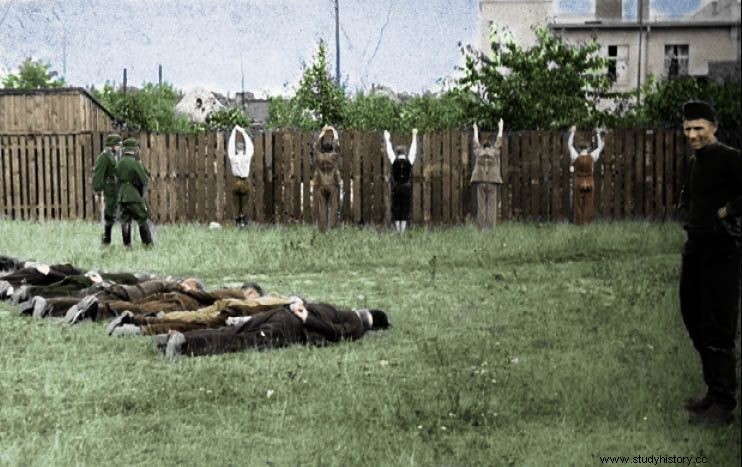
Arrests of Poles in the Bydgoszcz district of Szwederowo (An example from the book by Jochen Böhler entitled "Invasion 1939. Germany against Poland"; colorization of the RK).
Similar executions and murders of civilians took place also in many other villages:Bukownica, Grabów, Płudwiny, Wyszanów… Bydgoszcz. Bloody Sunday and even bloodier retaliation. Undoubtedly, it was in Bydgoszcz that the most controversial events took place during the entire September campaign.
According to the German version - which was repeatedly repeated by Goebbels' propaganda without sparing its strength - on the 3rd day of the war, the Polish army committed mass murder of defenseless, civilian German population in this city.
There is no doubt that the Germans did indeed die in Bydgoszcz on September 3:according to the Polish historian Paweł Kosiński, there were approximately two hundred and fifty victims on their side. Only that in the light of Polish historiography - as well as documentation prepared by the Polish Army - these were mainly members of German militias who undertook a subversive action before the Wehrmacht troops entered the city.
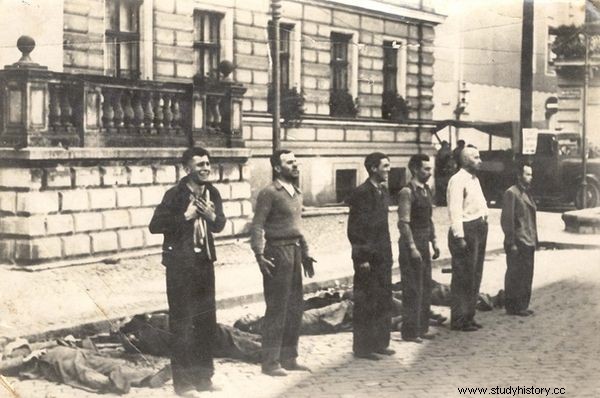
Execution of a group of Polish hostages in Bydgoszcz (source:public domain).
Regardless of how many civilians died in Bydgoszcz and how many militants, the Germans organized, in response to "Bloody Sunday" (this is how the events of September 3 was described by their propaganda), an unimaginably bloody retaliation. During the first four months of the occupation, murdered about 5,000 inhabitants of Bydgoszcz and its vicinity. Of these, 243 people were shot after the demonstration trials that even violated Nazi law.
Boryszew. Prisoners killed for Bloody Sunday
During the entire war, the Germans murdered about 10,000 inhabitants of Bydgoszcz, but the bloody revenge also reached Polish soldiers who could not have anything to do with the events of September 3.
On September 22, on the basis of a false report by a local Volksdeutsch , 50 taken prisoners were shot members of the Bydgoszcz Battalion of National Defense. In fact, this unit was outside the city on "Bloody Sunday". The demonstration group of soldiers destined for death was selected at random, noting that all the battalion officers were among the casualties. The condemned soldiers were killed on the day of the sentence under machine gun fire.
Przemyśl. Massacre of the Jewish people
Of course, the Jewish population also fell victim to the German murders. Particularly famous in this field was the operational group of Obergruppenführer Udo von Woychrsch, created by a special order of H. Himmler on September 3, 1939.

Przemyśl in September 1939 as seen through the lens of one of the soldiers of the 18th Army Corps. Photo and caption from the book from Jochen Böhler's book "The invasion of 1939. Germany against Poland."
Initially, it was supposed to fight the "uprising" in Upper Silesia, but it was quickly incorporated into the police forces of the 14th Army, whose special commander was just von Woychrsch.
Its "combat" trail marked hundreds of people killed and dozens of burned buildings (including a number of synagogues and prayer houses). Members of the Einsatzgruppe committed dozens of murders of Jews, but their " opus magnum ”There was a massacre in Przemyśl in this field. It was initiated on September 16 and lasted for several consecutive days. About 600 Jews lost their lives as a result of it , therefore, it is considered the largest massacre in a defensive war.
Ciepielów. Doubtful murder?
However, the most famous case of the crime committed by the Wehrmacht on Polish prisoners of war was the murder near Ciepielów. About 300 soldiers fell on September 8 one of the battalions of the 7th Infantry Division. Most likely, it was revenge for their resistance to captivity. The perpetrator of this shameful act was the 11th company of the 15th Motorized Infantry Regiment.
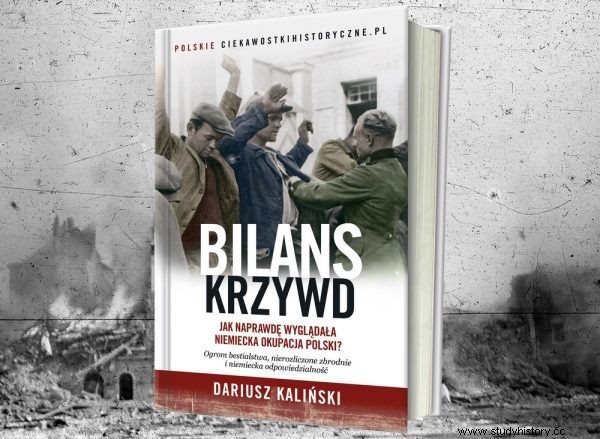
The truth about the horror of the German occupation in the book by Dariusz Kaliński entitled "Balance of harms" . Today order your copy with a discount on empik.com
In this case, the main evidence of the crime was an anonymous letter sent to the Polish consulate in Munich in 1950. It was most likely a fragment of a diary of one of the German soldiers, entitled "Unser erstes Gefecht in Polen" (Polish:Our first skirmish in Poland). It contained a description of the tragic events of the beginning of September.
An anonymous participant reported that the captured Poles were ordered to take off their uniform shirts - which was supposed to make them look like partisans - and the suspenders were cut, and then shot with machine guns, and the bodies were dumped in a roadside ditch .
Until recently, there was no doubt in Polish historiography that the Germans shot 300 Polish soldiers near Ciepielów. Nevertheless, in recent years, native historians have begun to pose difficult questions on this issue. One of the people who thinks that the murder near Ciepielów is a myth is Janusz Ryt. He claims that we are dealing with a figment of communist propaganda, which they wanted to use against the newly created Federal Republic of Germany.
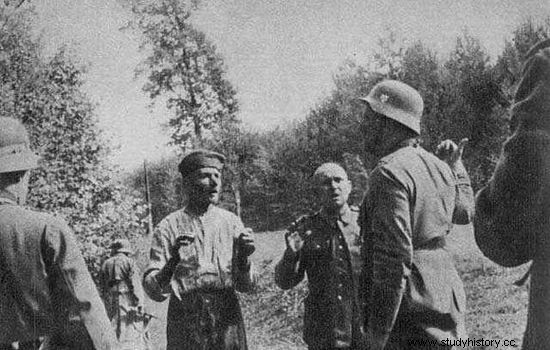
The photo is supposed to show Col. Walter Wessel, who ordered the execution of Polish prisoners of war near Ciepielów. However, did this particular crime actually take place?
This is evidenced, for example, by the inaccuracies in "Unser erstes Gefecht in Polen" (e.g. Polish Army soldiers did not use braces), no mention of an event before 1950, no reports of Polish soldiers and civilians that would confirm the murder of such a large group of prisoners of war, etc.
Of course, we are not going to pass our judgment here and decide how probable the position of Janusz Ryt is. We leave the judgment to the readers. Anyway, even if the crime in Ciepielów was not as large as previously thought, it does not in any way change the overall picture of the inhuman crimes committed by the Germans during the September campaign. Crimes that are too often forgotten today.
Sources:
Basic:
- Jochen Böhler, The invasion of 1939. Germany against Poland , Znak Publishing House, 2011.
- Jochen Böhler, Wehrmacht crimes in Poland. September 1939. Total war , Znak Publishing House, 2009
Complementary:
- Tomasz Chinciński, The German sabotage in Poland in 1939 in the light of the police and military documents of the Second Polish Republic and the special services of the Third Reich , part. 2 (August-September 1939) , "Remembrance and Justice", No. 1 (9) / 2006.
- Szymon Datner, Wehrmacht crimes against prisoners of war in World War II , Publishing house of the Ministry of National Defense, 1961.
- Janusz Ryt, Murder near Ciepielów in reports and documents , published by the author, 2009.
- Apoloniusz Zawilski, Battles of the Polish September , Społeczny Instytut Wydawniczy Znak 2011
